Equinox
| event | equinox | solstice | equinox | solstice | ||||
|---|---|---|---|---|---|---|---|---|
| month | March | June | September | December | ||||
| year | ||||||||
| day | time | day | time | day | time | day | time | |
| 2013 | 20 | 11:02 | 21 | 05:04 | 22 | 20:44 | 21 | 17:11 |
| 2014 | 20 | 16:57 | 21 | 10:51 | 23 | 02:29 | 21 | 23:03 |
| 2015 | 20 | 22:45 | 21 | 16:38 | 23 | 08:21 | 22 | 04:48 |
| 2016 | 20 | 04:30 | 20 | 22:34 | 22 | 14:21 | 21 | 10:44 |
| 2017 | 20 | 10:28 | 21 | 04:24 | 22 | 20:02 | 21 | 16:28 |
| 2018 | 20 | 16:15 | 21 | 10:07 | 23 | 01:54 | 21 | 22:23 |
| 2019 | 20 | 21:58 | 21 | 15:54 | 23 | 07:50 | 22 | 04:19 |
| 2020 | 20 | 03:50 | 20 | 21:44 | 22 | 13:31 | 21 | 10:02 |
| 2021 | 20 | 09:37 | 21 | 03:32 | 22 | 19:21 | 21 | 15:59 |
| 2022 | 20 | 15:33 | 21 | 09:14 | 23 | 01:04 | 21 | 21:48 |
| 2023 | 20 | 21:24 | 21 | 14:58 | 23 | 06:50 | 22 | 03:27 |
An equinox is commonly regarded as the moment when the plane (extended indefinitely in all directions) of Earth's equator passes through the center of the Sun,[2] which occurs twice each year: around 20 March and 22–23 September. In other words, it is the moment at which the center of the visible Sun is directly above the Equator.
However, because the Moon (and to a lesser extent the other planets) cause the true motion of the Earth to vary from a perfect ellipse, the equinox is now officially defined by the Sun's more regular ecliptic longitude rather than declination. The instants of the equinoxes are currently defined to be when the longitude of the Sun is 0° and 180°.[3] There are tiny (up to 1¼ arcsecond) variations in the Sun's latitude (discussed below), which means the Sun's center is rarely precisely over the equator under the official definition. The two understandings of the equinox can lead to discrepancies of up to 69 seconds.
On the day of an equinox, daytime and nighttime are of approximately equal duration all over the planet. They are not exactly equal, however, due to the angular size of the Sun, atmospheric refraction, and the rapidly changing duration of the length of day that occurs at most latitudes around the equinoxes. The word is derived from the Latin aequinoctium, from aequus (equal) and nox (genitive noctis) (night).
Equinoxes on Earth
General
The equinoxes are the only times when the solar terminator (the "edge" between night and day) is perpendicular to the equator. As a result, the northern and southern hemispheres are equally illuminated. The word comes from Latin Aequus, meaning "equal", and Nox, meaning "night".
In other words, the equinoxes are the only times when the subsolar point is on the equator, meaning that the Sun is exactly overhead at a point on the equatorial line. The subsolar point crosses the equator moving northward at the March equinox and southward at the September equinox.
The equinoxes, along with solstices, are directly related to the seasons of the year. In the northern hemisphere, the vernal equinox (March) conventionally marks the beginning of spring in most cultures and is considered the start of the New Year in Hindu calendar and the Persian calendar or Iranian calendars as Nowruz (means new day), while the autumnal equinox (September) marks the beginning of autumn.[4]


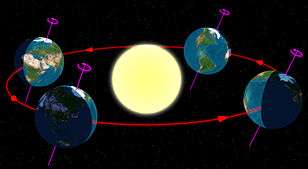 Diagram of the Earth's seasons as seen from the north. Far right: December solstice.
Diagram of the Earth's seasons as seen from the north. Far right: December solstice. Diagram of the Earth's seasons as seen from the south. Far left: June solstice.
Diagram of the Earth's seasons as seen from the south. Far left: June solstice.
Date
When Julius Caesar established the Julian calendar in 45 BC, he set 25 March as the date of the spring equinox which was already the starting day of year in Persian and Indian calendars. Because the Julian year is longer than the tropical year by about 11.3 minutes on average (or 1 day in 128 years), the calendar "drifted" with respect to the two equinoxes — such that in AD 300 the spring equinox occurred on about 21 March, and by AD 1500 it had drifted backwards to 11 March.
This drift induced Pope Gregory XIII to create a modern Gregorian calendar. The Pope wanted to continue to conform with the edicts concerning the date of Easter of the Council of Nicaea of AD 325, which means he wanted to move the vernal equinox to the date on which it fell at that time (21 March is the day allocated to it in the Easter table of the Julian calendar). However, the leap year intervals in his calendar were not smooth (400 is not an exact multiple of 97). This causes the equinox to oscillate by about 53 hours around its mean position. This in turn raised the possibility that it could fall on 22 March, and thus Easter Day might theoretically commence before the equinox. The astronomers chose the appropriate number of days to omit so that the equinox would swing from 19 to 21 March but never fall on the 22nd (although it can in a handful of years fall early in the morning of that day in the Far East).
Names
- Vernal equinox and autumnal equinox: these classical names are direct derivatives of Latin (ver = spring and autumnus = autumn). These are the historically universal and still most widely used terms for the equinoxes, but are potentially confusing because in the southern hemisphere the vernal equinox does not occur in spring and the autumnal equinox does not occur in autumn. The equivalent common language English terms spring equinox and autumn (or fall) equinox are even more ambiguous.[5][6][7] It has become increasingly common for people to mistakenly refer to the September equinox in the southern hemisphere as the Vernal equinox.[8][9]
- March equinox and September equinox: names referring to the months of the year in which they occur, with no ambiguity as to which hemisphere is the context. They are still not universal, however, as not all cultures use a solar-based calendar where the equinoxes occur every year in the same month (as they do not in the Islamic calendar and Hebrew calendar, for example).[10] Although the terms have become very common in the 21st century, they were sometimes used at least as long ago as the mid-20th century.[11]
- Northward equinox and southward equinox: names referring to the apparent direction of motion of the Sun. The northward equinox occurs in March when the sun crosses the equator from south to north, and the southward equinox occurs in September when the sun crosses the equator from north to south. These terms can be used unambiguously for other planets. They are rarely seen, although were first proposed over 100 years ago.[12]
- First Point of Aries and first point of Libra: names referring to the astrological signs the sun is entering. Due to the precession of the equinoxes, however, the constellations where the equinoxes are currently located are Pisces and Virgo, respectively.[13]
Length of equinoctial day and night
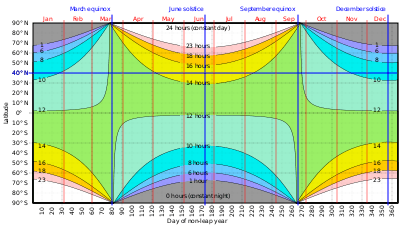
Day is usually defined as the period when sunlight reaches the ground in the absence of local obstacles. On the day of the equinox, the center of the Sun spends a roughly equal amount of time above and below the horizon at every location on the Earth, so night and day are about the same length. Sunrise and sunset can be defined in several ways, but a widespread definition is the time that the top limb of the sun is level with the horizon.[14] With this definition, the day is longer than the night at the equinoxes:[2]
- From the Earth, the Sun appears as a disc rather than a point of light, so when the centre of the Sun is below the horizon, its upper edge is visible. Sunrise, which begins daytime, occurs when the top of the Sun's disk rises above the eastern horizon. At that instant, the disk's centre is still below the horizon.
- The Earth's atmosphere refracts sunlight. As a result, an observer sees daylight before the top of the Sun's disk rises above the horizon.
In sunrise/sunset tables, the assumed semidiameter (apparent radius) of the Sun is 16 arcminutes and the atmospheric refraction is assumed to be 34 arcminutes. Their combination means that when the upper limb of the Sun is on the visible horizon, its centre is 50 arcminutes below the geometric horizon, which is the intersection with the celestial sphere of a horizontal plane through the eye of the observer.[15]
These effects make the day about 14 minutes longer than the night at the equator and longer still towards the poles. The real equality of day and night only happens in places far enough from the equator to have a seasonal difference in day length of at least 7 minutes,[16] actually occurring a few days towards the winter side of each equinox.
The times of sunset and sunrise vary with the observer's location (longitude and latitude), so the dates when day and night are equal also depend upon the observer's location.
A third correction for the visual observation of a sunrise (or sunset) is the angle between the apparent horizon as seen by an observer and the geometric (or sensible) horizon. This is known as the dip of the horizon and varies from 3 arcminutes for a viewer standing on the sea shore to 160 arcminutes for a mountaineer on Everest.[17] The effect of a larger dip on taller objects (reaching over 2½° of arc on Everest) accounts for the phenomenon of snow on a mountain peak turning gold in the sunlight long before the lower slopes are illuminated.
The date on which the day and night are exactly the same is known as an equilux; the neologism, believed to have been coined in the 1980s, achieved more widespread recognition in the 21st century. (Prior to this, the word "equilux" was more commonly used as a synonym for isophot, and there was no generally accepted term for the phenomenon.)[18][note 1] At the most precise measurements, there is no such thing as an equilux, because the lengths of day and night change more rapidly than any other time of the year around the equinoxes. In the mid-latitudes, daylight increases or decreases by about three minutes per day at the equinoxes, and thus adjacent days and nights only reach within one minute of each other. The date of the closest approximation of the equilux varies slightly by latitude; in the mid-latitudes, it occurs a few days before the spring equinox and after the fall equinox in each respective hemisphere.
Geocentric view of the astronomical seasons
In the half-year centered on the June solstice, the Sun rises north of east and sets north of west, which means longer days with shorter nights for the northern hemisphere and shorter days with longer nights for the southern hemisphere. In the half-year centered on the December solstice, the Sun rises south of east and sets south of west and the durations of day and night are reversed.
Also on the day of an equinox, the Sun rises everywhere on Earth (except at the poles) at about 06:00 and sets at about 18:00 (local solar time). These times are not exact for several reasons:
- The Sun is much larger in diameter than the Earth, so that more than half of the Earth could be in sunlight at any one time (due to unparallel rays creating tangent points beyond an equal-day-night line).
- Most places on Earth use a time zone which differs from the local solar time by minutes or even hours. For example, if a location uses a time zone with reference meridian 15° to the east, the Sun will rise around 07:00 on the equinox and set 12 hours later around 19:00.
- Day length is also affected by the variable orbital speed of the Earth around the sun. This combined effect is described as the equation of time. Thus even locations which lie on their time zone's reference meridian will not see sunrise and sunset at 6:00 and 18:00. At the March equinox they are 7–8 minutes later, and at the September equinox they are about 7–8 minutes earlier.
- Sunrise and sunset are commonly defined for the upper limb of the solar disk, rather than its center. The upper limb is already up for at least a minute before the center appears, and the upper limb likewise sets later than the center of the solar disk. Also, when the Sun is near the horizon, atmospheric refraction shifts its apparent position above its true position by a little more than its own diameter. This makes sunrise more than two minutes earlier and sunset an equal amount later. These two effects combine to make the equinox day 12 h 7 min long and the night only 11 h 53 min. Note, however, that these numbers are only true for the tropics. For moderate latitudes, the discrepancy increases (e.g., 12 minutes in London); and closer to the poles it becomes very much larger (in terms of time). Up to about 100 km from either pole, the Sun is up for a full 24 hours on an equinox day.
- Height of the horizon changes the day's length. For an observer atop a mountain the day is longer, while standing in a valley will shorten the day.
Day arcs of the Sun
Some of the statements above can be made clearer by picturing the day arc (i.e., the path along which the Sun appears to move across the sky). The pictures show this for every hour on equinox day. In addition, some 'ghost' suns are also indicated below the horizon, up to 18° below it; the Sun in such areas still causes twilight. The depictions presented below can be used for both the northern and the southern hemispheres. The observer is understood to be sitting near the tree on the island depicted in the middle of the ocean; the green arrows give cardinal directions.
- In the northern hemisphere, north is to the left, the Sun rises in the east (far arrow), culminates in the south (right arrow), while moving to the right and setting in the west (near arrow).
- In the southern hemisphere, south is to the left, the Sun rises in the east (near arrow), culminates in the north (right arrow), while moving to the left and setting in the west (far arrow).
The following special cases are depicted:
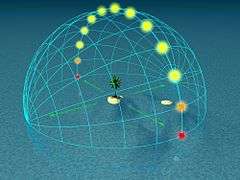 Day arc at 0° latitude (equator)
Day arc at 0° latitude (equator)
The arc passes through the zenith, resulting in almost no shadows at high noon.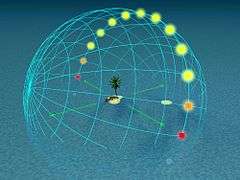 Day arc at 20° latitude
Day arc at 20° latitude
The Sun culminates at 70° altitude and its path at sunrise and sunset occurs at a steep 70° angle to the horizon. Twilight still lasts about one hour. Day arc at 50° latitude
Day arc at 50° latitude
Twilight lasts almost two hours.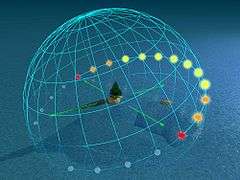 Day arc at 70° latitude
Day arc at 70° latitude
The Sun culminates at no more than 20° altitude and its daily path at sunrise and sunset is at a shallow 20° angle to the horizon. Twilight lasts for more than four hours. Day arc at 90° latitude (pole)
Day arc at 90° latitude (pole)
If it were not for atmospheric refraction, the Sun would be on the horizon all the time.
Celestial coordinate systems
The March equinox occurs about when the Sun appears to cross the celestial equator northward. In the Northern Hemisphere, the term vernal point is used for the time of this occurrence and for the precise direction in space where the Sun exists at that time. This point is the origin of some celestial coordinate systems, which are usually rooted to an astronomical epoch since it gradually varies (precesses) over time:
- in the ecliptic coordinate system, the vernal point is the origin of the ecliptic longitude;
- in the equatorial coordinate system, the vernal point is the origin of the right ascension.
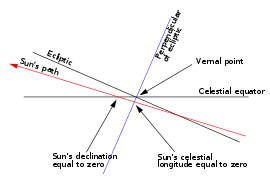
Strictly speaking, at the equinox, the Sun's ecliptic longitude is zero. Its latitude will not be exactly zero, since Earth is not exactly in the plane of the ecliptic. Its declination will not be exactly zero either. (The ecliptic is defined by the barycenter of Earth and the Moon combined.) The modern definition of equinox is the instants when the Sun's apparent geocentric longitude is 0° (northward equinox) or 180° (southward equinox).[19][20][21] See the adjacent diagram.
Because of the precession of the Earth's axis, the position of the vernal point on the celestial sphere changes over time, and the equatorial and the ecliptic coordinate systems change accordingly. Thus when specifying celestial coordinates for an object, one has to specify at what time the vernal point and the celestial equator are taken. That reference time is called the equinox of date.[22]
The autumnal equinox is at ecliptic longitude 180° and at right ascension 12h.
The upper culmination of the vernal point is considered the start of the sidereal day for the observer. The hour angle of the vernal point is, by definition, the observer's sidereal time.
Using the current official IAU constellation boundaries – and taking into account the variable precession speed and the rotation of the celestial equator – the equinoxes shift through the constellations as follows[23] (expressed in astronomical year numbering when the year 0 = 1 BC, −1 = 2 BC, etc.):
- The March equinox passed from Taurus into Aries in year −1865, passed into Pisces in year −67, will pass into Aquarius in year 2597, and then into Capricornus in year 4312. In 1489 it came within 10 arcminutes of Cetus without crossing the boundary.
- The September equinox passed from Libra into Virgo in year −729, will pass into Leo in year 2439.
Cultural aspects
The equinoxes are sometimes regarded as the start of spring and autumn. A number of traditional harvest festivals are celebrated on the date of the equinoxes.
Observations of the equinox are frequently used in online debates between flat earth conspiracy proponents and those who support the generally-accepted heliocentric globe model. Wolfie6020, a well-known flat earth debunker on YouTube, has a semi-annual Equinox Challenge with prizes available to any flat earther who can show a functioning flat earth model that can match observations on the equinox. As of September 2018, no flat earther has succeeded in winning the prize. Modern flat earth proponents typically cite an azimuthal equidistant projection map to explain the daily and annual movement of the sun and moon, a sort of circling pattern around the north pole, oscillating between the tropics throughout the year. However, proponents of the globe model point out that observations of the equinox sunrise and sunset azimuths (at 090 east and 270 west all over earth) match the globe model but cannot be reconciled with a localized overhead sun above a flat plane.
Effects on satellites
One effect of equinoctial periods is the temporary disruption of communications satellites. For all geostationary satellites, there are a few days around the equinox when the sun goes directly behind the satellite relative to Earth (i.e. within the beam-width of the ground-station antenna) for a short period each day. The Sun's immense power and broad radiation spectrum overload the Earth station's reception circuits with noise and, depending on antenna size and other factors, temporarily disrupt or degrade the circuit. The duration of those effects varies but can range from a few minutes to an hour. (For a given frequency band, a larger antenna has a narrower beam-width and hence experiences shorter duration "Sun outage" windows.)
Equinoxes on other planets
Equinoxes occur on any planet with a tilted rotational axis. A dramatic example is Saturn, where the equinox places its ring system edge-on facing the Sun. As a result, they are visible only as a thin line when seen from Earth. When seen from above – a view seen during an equinox for the first time from the Cassini space probe in 2009 – they receive very little sunshine, indeed more planetshine than light from the Sun.[24] This phenomenon occurs once every 14.7 years on average, and can last a few weeks before and after the exact equinox. Saturn's most recent equinox was on 11 August 2009, and its next will take place on 6 May 2025.[25]
Mars's most recent equinox was on 22 May 2018 (northern autumn), and the next will be on 23 March 2019 (northern spring).[26]
See also
- Anjana (Cantabrian mythology) – fairies believed to appear on the spring equinox
- Aphelion – occurs around 5 July (see formula)
- Kōreisai – days of worship in Japan that began in 1878
- Lady Day
- Nowruz
- Solstice
- Songkran
- Sun outage – a phenomenon that occurs around the time of an equinox
- Tekufah
Notes
- ↑ This meaning of "equilux" is rather modern (c. 1985 to 1986) and unusual. Technical references since the beginning of the 20th century (c. 1910) use the terms "equilux" and "isophot" to mean "of equal illumination" in the context of curves showing how intensely lighting equipment will illuminate a surface. See for instance John William Tudor Walsh, Textbook of Illuminating Engineering (Intermediate Grade), I. Pitman, 1947. The earliest confirmed use of the modern meaning was in a post on the Usenet group net.astro dated 14 March 1986 net.astro – Spring Equilux Approaches, which refers to "discussion last year exploring the reasons why equilux and equinox are not coincident". Use of this particular pseudo-latin protologism can only be traced to an extremely small (less than six) number of predominently US American people in such online media for the next 20 years until its broader adoption as a neologism (c. 2006), and then its subsequent use by more mainstream organisations (c. 2012) The Equinox and Solstice, UK Meteorological Office.
References
- ↑ United States Naval Observatory (4 January 2018). "Earth's Seasons and Apsides: Equinoxes, Solstices, Perihelion, and Aphelion". Retrieved 18 September 2018.
- 1 2 "Equinoxes". Astronomical Information Center. United States Naval Observatory. Retrieved 4 September 2015.
- ↑ "Glossary". Astronomical Almanac 2008. United States Naval Observatory. 2008.
- ↑ "March Equinox – Equal Day and Night, Nearly". Time and Date. 2017. Retrieved 22 May 2017.
- ↑ Michelle Skye (2007). Goddess Alive!: Inviting Celtic & Norse Goddesses Into Your Life. Llewellyn Worldwide. pp. 69–. ISBN 978-0-7387-1080-8.
- ↑ Howard D Curtis (5 October 2013). Orbital Mechanics for Engineering Students. Butterworth-Heinemann. pp. 188–. ISBN 978-0-08-097748-5.
- ↑ Mohinder S. Grewal; Lawrence R. Weill; Angus P. Andrews (5 March 2007). Global Positioning Systems, Inertial Navigation, and Integration. John Wiley & Sons. pp. 459–. ISBN 978-0-470-09971-1.
- ↑ Nathaniel Bowditch; National Imagery and Mapping Agency (2002). The American practical navigator : an epitome of navigation. Paradise Cay Publications. pp. 229–. ISBN 978-0-939837-54-0.
- ↑ Exploring the Earth. Allied Publishers. pp. 31–. ISBN 978-81-8424-408-3.
- ↑ Paula LaRocque (2007). On Words: Insights Into How Our Words Work – And Don't. Marion Street Press. pp. 89–. ISBN 978-1-933338-20-0.
- ↑ Popular Astronomy. 1945.
- ↑ Notes and Queries. Oxford University Press. 1895.
- ↑ Spherical Astronomy. Krishna Prakashan Media. pp. 233–. GGKEY:RDRHQ35FBX7.
- ↑ Forsythe, William C; Rykiel, Edward J; Stahl, Randal S; Wu, Hsin-i; Schoolfield, Robert M (1995). "A model comparison for daylength as a function of latitude and day of year". Ecological Modelling. 80: 87. doi:10.1016/0304-3800(94)00034-F.
- ↑ Seidelman, P. Kenneth, ed. (1992). Explanatory Supplement to the Astronomical Almanac. Mill Valley, CA: University Science Books. p. 32. ISBN 0-935702-68-7.
- ↑ "Sunrise and Sunset". 21 October 2002. Retrieved 22 September 2017.
- ↑ Biegert, Mark (21 October 2015). "Correcting Sextant Measurements For Dip". Math Encounters (blog). Retrieved 22 September 2017.
- ↑ Owens, Steve (20 March 2010). "Equinox, Equilux, and Twilight Times". Dark Sky Diary (blog). Retrieved 31 December 2010.
- ↑ United States Naval Observatory (2006). Astronomical Almanac 2008. Glossary Chapter.
- ↑ Meeus, Jean (1997). Mathematical Astronomy Morsels.
- ↑ Meeus, Jean (1998). Astronomical Algorithms, Second Edition.
- ↑ Montenbruck, Oliver; Pfleger, Thomas. Astronomy on the Personal Computer. Springer-Verlag. p. 17. ISBN 0-387-57700-9.
- ↑ J. Meeus; Mathematical Astronomical Morsels; ISBN 0-943396-51-4.
- ↑ "PIA11667: The Rite of Spring". Jet Propulsion Laboratory, California Institute of Technology. Retrieved 21 March 2014.
- ↑ Lakdawalla, Emily (7 July 2016). "Oppositions, conjunctions, seasons, and ring plane crossings of the giant planets". The Planetary Society. Retrieved 31 Jan 2017.
- ↑ Mars Calendar. The Planetary Society.
External links
| Look up equinox in Wiktionary, the free dictionary. |
| Wikimedia Commons has media related to Equinox. |
| Wikiquote has quotations related to: Equinox |
- Day and Night World Map (night and day map on equinox)
- Calculation of Length of Day (Formulas and Graphs)
- Equinoctial Points – The Nuttall Encyclopædia
- Table of times for Equinoxes, Solstices, Perihelion and Aphelion in 2000–2020
- Table of times of Spring Equinox for a thousand years: 1452–2547
- Gray, Meghan; Merrifield, Michael. "Solstice and Equinox". Sixty Symbols. Brady Haran for the University of Nottingham.
